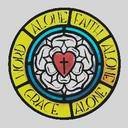
“…the deformation must be extirpated from the face of the Earth.”
-Catholic apologist, Art Sippo
Catholic apologist Art Sippo responded to my recent comments on Luther and Patrick O’Hare’s book The Facts About Luther, as well as some other authors. He also offered a fair amount of tangential material. This will be the first part of my review of his comments. I’ve tried to keep my responses organized by topic. To view Art’s side of things, click here and scroll down to about the 13th post in the thread. I'm assuming this topic may bore some of you to tears, but I find it helpful to understand what information motivates Catholics toward hostile polemic.
Hello Dr. Sippo,
Thank you a detailed response, and sharing your feelings about Luther scholarship. You gave me a lot to respond to- some of it, I feel, rather tangential (no offense intended here).
I don't expect either of us to agree on very much. I don't even dialog with you with a "hope" of changing your mind on anything- and likewise, you shouldn't think that you're going to change my mind on anything either. This dialog though interests me, because rarely will I find someone able to defend the earlier, outdated approach to Luther that began with Cochlaeus, and more-a-less ended with Patrick O'Hare.
This tradition, is a tradition of destructive criticism that generally attacks Luther "the person". During the first few hundred years of Catholic evaluations of Luther, a strong emphasis on vilifying Luther’s character as a means of discrediting the Reformation was the normal Catholic approach.The emphasis shifted in the Twentieth Century: Catholics began to study Luther as a sincere religious man and an honest theologian.
Art Sippo on Patrick O’Hare’s "Facts About Luther"
Sippo earlier said that O’Hare book “was written in the mid-19th Century.” After my correction, he commented, “While Fr. O'Hare's book was published in 1917, it represented 19th Century scholarship.” This is true- In Catholic approaches to Luther, O’Hare’s book was kind of the last stop in this type of pseudo-scholarship which had gone on for a few hundred years, and had peaked in the 19th Century. O’Hare’s book more-a-less echoes earlier work which came before his. Interestingly though, Sippo doesn’t note his earlier mistake and my correction- not sure why.
As to his comment on Luther’s sermon on marriage that was transcribed by a student, and subsequently not mentioned in later biographies, Sippo gives no further information. It is a historical curiosity for me, and I was hoping Sippo could document it. This being said, our interaction on O’Hare’s book is probably over. Sippo already distanced himself from the accuracy of the book, and I don’t blame him. I’m hopeful Catholic laymen will follow his lead here.
Art Sippo on the Catholic Historian, Joseph Lortz
Sippo says:
“I have some quibbles about Lortz. He was a Catholic Scholar who was very "German" before and during WWII. He was very conciliatory towards the Nazis and the Lutherans. Remember that Luther was seen by the Nazis both as a great German hero and a supporter of anti-Semitism. These facts have discredited most of what he wrote.”
Sippo discredits Lortz’s work on Luther due to Nazis and WWII. To my knowledge, Lortz was never charged with war crimes, nor kicked out of the Roman Catholic Church. He is known as perhaps the most famous Catholic Luther scholar of the twentieth century. Protestants and Catholics alike refer to his work on Luther as monumental. He continued his work on Luther after WWII as well, influencing an entire field of excellent Catholic Luther researchers (like Jared Wicks). For Sippo’s claim to be justified, he should be able to produce Nazi-conciliatory remarks from Lortz’s work on Luther. It should be obvious to everyone: simply because Lortz was "wrong" about the Nazi party, does not mean he is "wrong" about Luther. It is a logical fallacy is thinking that because he was wrong on one thing, he's therefore "wrong" on all things.
Interestingly, Lortz ultimately concludes Luther was a heretic.
Sippo may find this quote interesting:
“Three of the five theologians whom Krieg analyses, Eschweiler, Lortz and Adam, achieved later notoriety for their open support for the new Nazi regime, at least to begin with. Together with lesser-known figures whom Krieg discusses, their motives were extremely varied. In fact, as he points out, none of these men can be seen as representative of the whole Catholic milieu. Despite the prestige of these professors, their affirmations were matched by the opposing views held by their colleagues and bishops. Karl Eschweiler would seem to have been a firm authoritarian. Hitler's leadership against modernity and especially against the Bolshevik danger was the main attraction. Joseph Lortz however had a much grander vision. He looked for the renewal of Western civilization, whereby Hitler's political energies could be united with Catholic spirituality. Such co-operation, as Mussolini had shown, could be beneficial in rebuilding a spiritually vibrant society along organic lines. It was, as Victor Conzemius pointed out, "idealism separated from reality".
To be fair, Lortz soon enough began to recognize that the Nazi movement contained other and more dangerous elements. His subsequent withdrawal was sufficient to enable him to resume a long and fruitful academic career after the war.”[Source]
Dr. Sippo's comments on Lortz are out of touch with the consensus:
“It was not until 1939, when Joseph Lortz. The Catholic professor at Muenster, published his fine two-volume study of Luther, entitled Die Reformation in Deutschland (1939-40), that the first ray of hope of any creative theological dialogue between Catholicism and Protestantism lit the dark horizon. The work was so scholarly and so informed that it was found to subserve a highly significant and irenic critique of Luther and Lutheranism.” [James Atkinson, Martin Luther: Prophet to the Church Catholic, (Michigan: Wm. B. Eerdmans Publishing Co., 1983), 3].
“the popular demonization of Luther started in the 16th Century by Luther’s opponent Cochlaeus was “so lasting that …the entire Catholic historiography of the Reformation until the publication in 1939 of Joseph Lortz’s magnum opus came under the spell of such powerful polemic [that of Cochlaeus].”[Ulrich Kremer comments from the book,“ Seven Headed Luther” Oxford Press, 1983, 207. In the same book, Gotthelf Wiedermann agrees: “It was only in the twentieth century that Cochlaeus’s hold on the Catholic image of Luther was gradually broken [because of Lortz], 204].
“With Lortz' great three hundred page essay on Luther, Catholics left behind the unscrupulous hatred of Cochlaeus (whose legends of 1549 turned up monotonously in Catholic works on Luther for over three hundred and fifty years), the charges of immorality and ignorance leveled by Denifle, the cold and one-sided reading of Grisar.” [“Catholic Scholars Dialogue with Luther”(Jared Wicks, S.J, Editor. 1970, Loyola University Press), 1].
“…Denifle and the Jesuit Hartman Grisar, used Freudian psychology to arrive at their assessment that Luther was a monk obsessed with the lust of the flesh and a pathological manic-depressive personality….These polemical portraits were corrected in the 1940’s when an ecumenically oriented scholar, Joseph Lortz, rejected Freudian psycho-historical methods in favor of a more objective critical assessment to depict Luther as a faithful priest-professor who had succumbed to ‘subjectivism.”[ Eric W. Gritsch, Martin Luther-God’s Court Jester, Luther in Retrospect ( Fortress press, 1983), 146.
Johann Heinz points out, “Lortz tried seriously to understand Luther and the Reformation. In one stroke he abandoned, once and for all, the polemical approach, denying, for example, the legend of Luther's immorality. Lortz declares that "Luther was not motivated by low inclinations and desires when he broke with the church . . . this ought to be understood by everyone." The Reformation was inevitable, Lortz suggests, with the Catholic Church having been guilty of corrupting the life and thought of medieval Christianity” [Johann Heinz, “Martin Luther and his Theology in German Catholic Interpretation Before and After Vatican II,” (Andrews University Seminary Studies, 1988, Vol. 26, No. 3), 256].
Art Sippo on Catholic Writer, John Todd
Sippo says:
“Todd's work in the 1960s was written in Ecumenical fervor and IMHO does not point out the clearly dark side of Luther and the Lutheran movement. Luther was excommunicated and condemned by the Catholic Church as a heretic. You would never know that reading Todd. He is not critical enough. I do not recommend him.”
I suggested Todd’s book for its writing style- his work is extremely reader friendly, particularly for those who haven’t read anything on Luther. Todd’s books are a well-balanced approach to Luther: one senses neither a lurking negative polemic or an obvious adulation. Todd simply puts forth the big facts, and presents a balanced case from a Catholic perspective. If you’re looking for a Jerry Springer type of “shocker” or National Enquirer style of distorted facts, Todd’s book is not for you. If you’re level headed and you want to get a good overview of the big picture from well written books, then pick up John Todd’s offerings on Luther.
Todd does criticize Luther, for instance:
“…[Todd] blames [Luther] for having denied the Sacrifice of the Mass, for having deprived the sacraments of their objective character by repudiating the concept of the opus operatum, for having drawn from his doctrine of original sin, catholic in essence, a distinction without Scriptural foundation, for having approved the rise of an irrational fideism, and finally for having rejected the authority of Pope and Councils. On this last point, which played a large part in Luther's condemnation of Rome, Todd is careful to draw our attention to the pertinent fact that Catholicism held a different position in the sixteenth century from today; the authority of the Pope was not then regarded as necessarily instituted by God, and his relations with councils was still under discussion.”[Richard Stauffer, Luther As Seen By Catholics, Virginia: John Knox Press, 1967, 67-68].
“[Todd] does full justice to Luther's innermost religious and theological intentions, while at the same time criticizing him for having denied the sacrifice of the mass, for having repudiated the objective nature of the sacraments, for having drawn non-biblical conclusions in his doctrine of original sin, for inaugurating a kind of irrational fideism, and for having rejected the authority of popes and councils. There is little in the book not already found elsewhere (in Rupp, for example, and in Lortz); nevertheless it is a valuable book to have at the present, issuing as it does from the pen of a sensitive and fair-minded lay historian of the Roman Catholic Church.” [James Atkinson, Martin Luther: Prophet to the Church Catholic, 33].
Sippo says, “Luther was excommunicated and condemned by the Catholic Church as a heretic. You would never know that reading Todd.” Actually, what Todd does is put history in context. Todd argues that Rome was not able to address Luther constructively or helpfully on the 95 Theses. The Church was mired in abuse, and its theologians had no desire to hear from one Luther. If Catholics want to deal honestly with Luther, they have to take responsibility for the subterfuge that surrounded the 95 Theses. I appreciate the fact that Todd is not afraid to do. For this, I respect him and his work.
Art Sippo on Heinrich Denifle
Sippo says,
“Fr. Denifle needs a little defending. He was an expert in medieval texts. When the 1893 celebration of Luther's birth was going on in Germany, Fr Denifle saw that the German Protestants were touting Luther as the founder of religious freedom and personal autonomy. Fr. Denifle was surprised though that they rarely quoted from Luther's works to that effect. He dug into the archives where only scholars had previously gone and he found evidence of Luther's intemperate personality, his intolerance, and his gross logical inconsistency in what he wrote. He also resurrected the complaints of many of Luther's contemporaries about the man's erratic behavior and his excesses. It is Fr. Denifle who brought these things to light and spurred on the more critical portrait of Luther that would emerge in the 20th Century from Fr. Grisar, Preserved Smith, Paul Reiter, Erik Ericsson, Marius, and Rix.”
The Catholic Encyclopedia states that Heinrich Denifle was one of the best Austrian Catholic preachers in the 1880’s, and “beloved by Leo XIII and Pius X.” He was also an accomplished scholar, with groundbreaking work on the relationship between scholastic theology and medieval mysticism. I was surprised to find Sippo so exuberant about his work on Luther. Here are some basic “Facts” about Denifle’s approach to Luther:
“The evidence which Denfile presented [about Luther] was certainly impressive and his influence on anti-Lutheran writers has been continuous and considerable; but it had been marshaled in a distinctly slanted fashion He had, for instance, laid great stress on Luther's use of the word ‘concupiscentia', mistakeningly interpreting it as sexual lust. He quoted a phrase which Luther used in a letter to his wife, 'I gorge myself like a Bohemian and I get drunk like a German. God be praised. Amen', to suggest that he was a worldly man, but he did not note the context of the letter, a humorous one written to his wife when she was very worried by his poor appetite. He used a series of portraits in his first edition to show how the thin, ascetic scholar and monk became obese and unattractive; the last of his portraits, he noted, was surprisingly bestial', though the fact that it was made of the reformer after his death, and possibly after decomposition had set in, should have minimized his astonishment.”[ V.H.H. Green, Luther and the Reformation (New York: G.P.Putnum’s Sons, 1964) 193-195].
“Denifle has grossly misrepresented [Luther] in identifying [Luther’s admitting of sins] with the lusts of the flesh, and his theory that the sensual tendency ultimately led him to a sense of moral bankruptcy and induced him to take refuge in the doctrine of justification by faith alone is utterly misleading. It is not shared by reasonable Roman Catholic writers like Kiefl, who have rightly discarded the theory of Denifle and his followers Grisar, Paquier, Cristiani as untenable.” [James Mackinnon, Luther and the Reformation Vol. I (New York: Russell & Russell, 1962), 105].
The bias of Denifle is overtly apparent. Catholic scholar Jared Wicks points out the immediate reaction to Denifle’s work from Catholic scholars:
“Catholic university men in Germany were reserved about Denifle’s bombshell from Rome. Some coolly pointed out that a person so depraved as the Luther depicted by Denifle could not possibly have produced the literature that in fact changed the course of Christian history. It was lamented that the new documents Denifle presented would never lead to corrections of Lutheran views of Luther, since the Dominican had clothed his work in a vitriolic rhetoric repulsive to Lutherans.” [Jared Wicks, Luther and His Spiritual Legacy, 18].
Joseph Lortz unmasks the link between Cochlaeus and Denifle, and clearly expresses that he purposefully has abandoned:
“the evaluative categories of a Cochlaeus, … dominated [Catholic Luther studies] for over 400 years, and those of the great Denifle…. Gradually Catholics have come to recognize the Christian, and even Catholic, richness of Luther, and they are impressed. They now realize how great the Catholic guilt was that Luther was expelled from the Church to begin the division that burdens us so today--even in theology. Finally, we are anxious to draw Luther's richness back into the Church. ” [Jared Wicks (ed.) Catholic Scholars Dialogue with Luther (Loyola University Press, 1970), 6-7].
James Atkinson says, “Denifle's thesis has wreaked irreparable harm to the Catholic understanding of Luther, and has exercised an astonishing influence on Catholicism in general and on Catholic scholarship in particular, which one might have thought impervious to such impassioned and biased thinking.” [James Atkinson, Martin Luther: Prophet to the Church Catholic , 11.].
Denifle’s attacks though did have this positive aspect: he forced Protestant scholars to do even greater research into Luther, particularly to reviewing the early years of Luther’s life and medieval scholasticism.
This ends part one of my response to Art Sippo's opinions on particular authors who have written on Martin Luther. One should be able to see what's going with Sippo's approach: Sippo maintains a 19th Century Roman Catholic approach to Luther. That negative polemical tradition has by and far been abandoned by Catholic historians.














